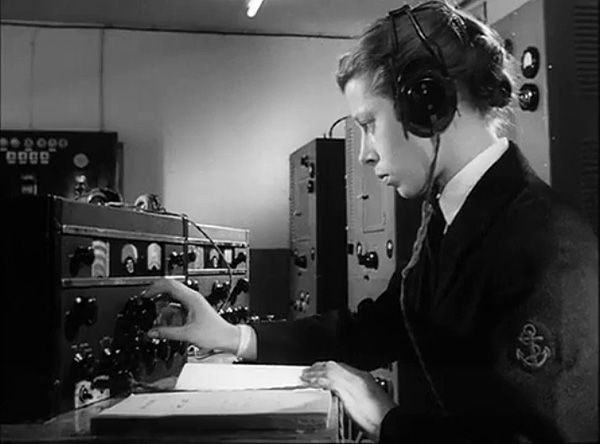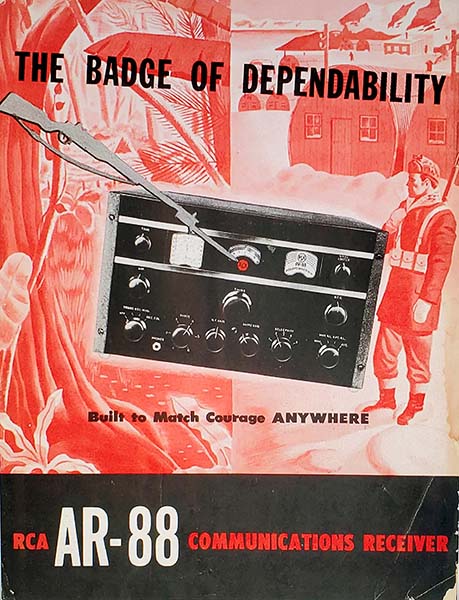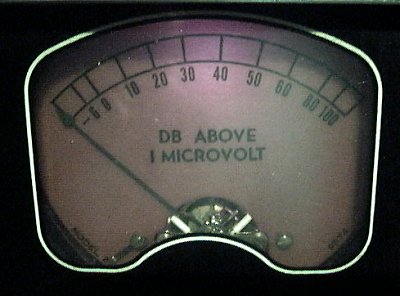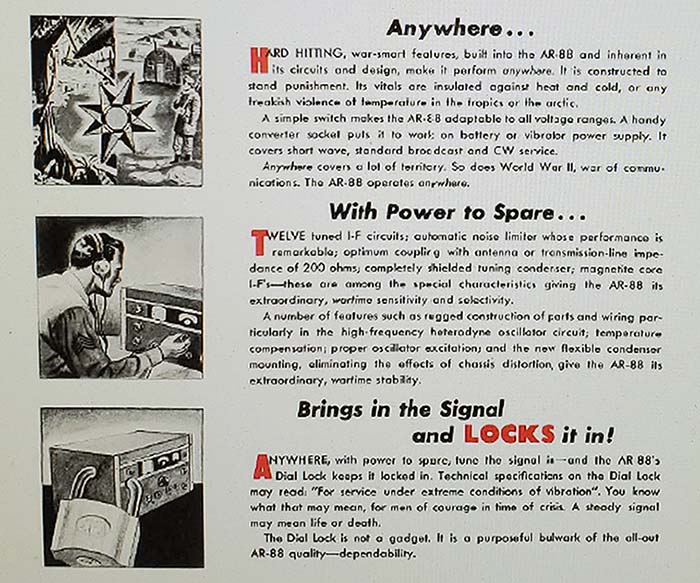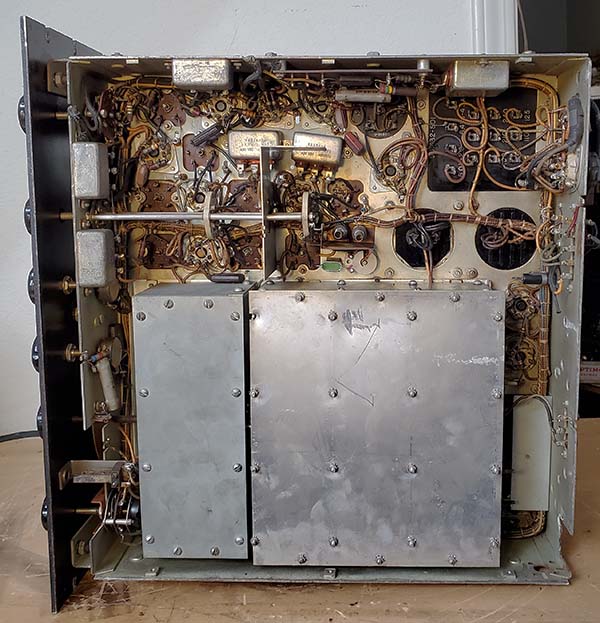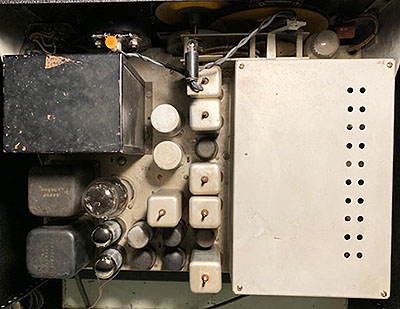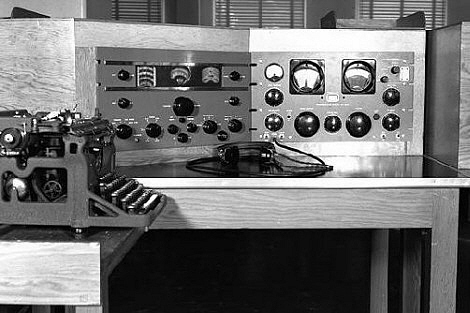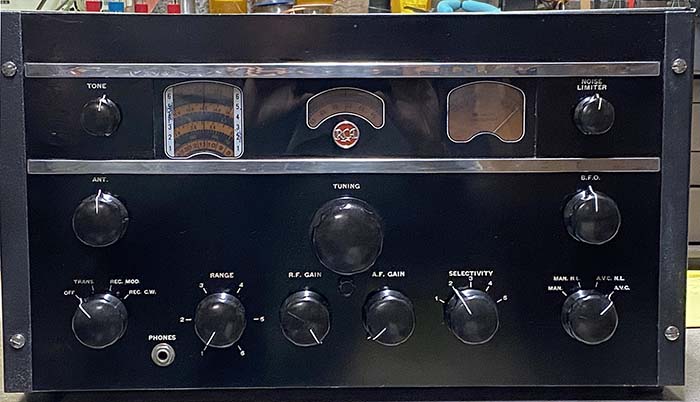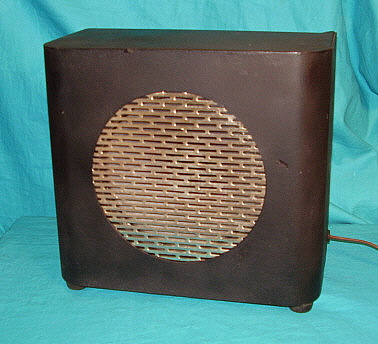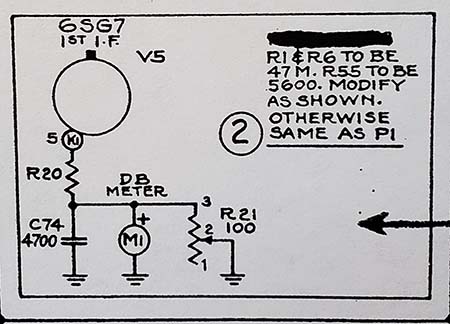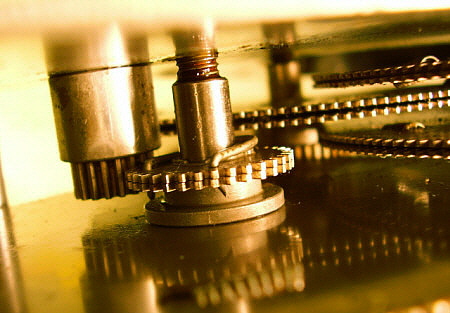|

RCA AR-88D - 1944 version |
History of the AR-88 Series
RCA's greatest general purpose communications receiver creation was the AR-88,
a receiver that achieved its renown by providing top performance and high
reliability in service as a surveillance and intercept receiver during
WWII and later as a "workhorse" for the RCA and Radiomarine
Corporation of America coastal stations, usually in triple diversity
receivers that provided world-wide ship-to-shore message handling. RCA's
AR-88 planning may have chronologically followed their AR-77 ham
receiver but the AR-88 owes much of its design concept as a replacement
for RCA's marine-durable, very expensive commercial-military receiver, the AR-60. The AR-60 had
been introduced in 1935 and was still being built as late as 1940
(CGR-32-1 USCG contract Nov. 1939.) RCA
did produce a small quantity of AR-80 receivers that were a more robust,
portable
version of the AR-77 for the military but the circuit wasn't as
sophisticated as the AR-88. RCA had to come up with a modern, highly reliable military/commercial product
that would meet the needs of WWII and the AR-88 was the result.
Design stages probably date from as early as late-1939 and the demands of
WWII in Europe pushed RCA into having the AR-88 ready by early 1941. The finalized AR-88 was a 14 tube superheterodyne
that covered .54 to 32MC in six tuning ranges, featuring incredible
sensitivity (even up to 10 meters), excellent stability and high
fidelity audio along with mechanical and electronic reliability that
couldn't be found in most other receivers of the day. The electronic design was the work of Lester T. Fowler
while George Blaker handled the mechanical design. The actual production
during WWII was handled by RCA's Export Sales under Charles Roberts in
Camden, New Jersey. Additional receivers were produced at RCA facilities
in Bloomington, Indiana and Montreal, Quebec, Canada. Grisby-Grunow Co.
is sometimes mentioned as an AR-88 contractor during WWII but this
company went bankrupt in 1934.
The AR-88 Outside the USA
- Most of the early AR-88 production was sent to Great Britain
or Russia (and to a lesser extent China and France) during WWII through
Lend-Lease and this accounts for the scarcity of the early versions of
the receiver in the USA. The Lend-Lease Act of October 1941, allowed the
USA to supply materiel to our Allies in exchange for permission to build
and operate bases in the allied countries or territories.
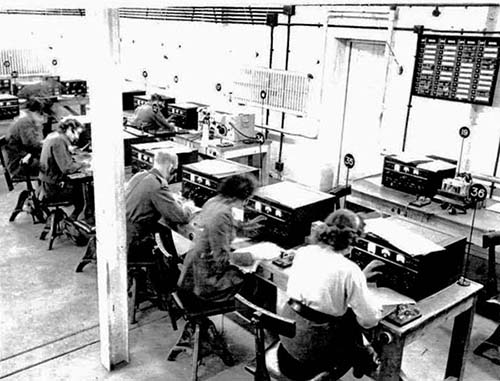 |
The AR-88 was used extensively in Great Britain during WWII
for varied purposes. The photo to the left shows Special
Operations Executive's (SOE) Wireless Receiving Station STS 53b at Poundon,
Oxfordshire, England in early 1945. This station provided
message reception and communications with SOE agents.
photo from: Richard Smith, whose mother is operating at Station
36 (foremost op.) |
Many of
the Allies required coverage of the LF and MF parts of the spectrum and
the AR-88LF was created for that service, providing coverage from 70kc
to 550kc continuous and 1.5mc to 30mc continuous. Building of the
AR-88LF receivers was handled by the RCA plant in Montreal, Quebec,
Canada. RCA-Camden, NJ, USA
supplied the CR-91 receiver possibly to supplement demand for
AR-88LF-type receivers.
|

The CR-91 - Camden-built version of the AR-88LF from 1944 |
By the end of WWII, it certainly seemed like tens of
thousands of AR-88 receivers had been shipped overseas to our allies.
However, careful examination of serial numbers indicate a production
level that was far less than the customary published estimates. While it
may have seemed like "AR-88s were everywhere" the actual production
numbers did not exceed 25,000 units (total WWII production of AR-88D,
AR-88F, AR-88LF and CR-91 receivers, that's still a lot of receivers.)
 |
The AR-88 was used for several purposes by Great Britain during
WWII. This is a photo of the Portsdown Tunnel communications
center that handled wartime communications. Note
that the WREN (Womens Royal Navy Service) to the left is using an AR-88 as the
communications receiver.
photo from: www.portsdown-tunnels.org.uk
|
Many of the British AR-88s were destroyed after WWII ended. This
was due to the provisions in the Lend-Lease Act which stated
that materiel had to be either returned or destroyed. In just
one incident, a load of AR-88 receivers was "dumped" into an
abandoned well by USA forces after the war ended. Some sources
even indicate that RCA had made it clear they did not want to
see the receivers back in the USA for any reason. The AR-88
survivors, along with other surviving materiel, generally were
placed in groupings that were "sold back" to Great Britain at
discount, which was usually at "ten cents on the dollar" or less
(and was probably based on the "scrap value" rather than the original cost.)
|
| Still, lots of the AR-88s survived and they were
considered a common and easily
available receiver in Great Britain for several decades after
WWII. The easy availability of AR-88s made them a
popular amateur receiver in the 1950s and 1960s. Shown
to the right
is the typical British ham, G5FA, with his AR-88D station receiver.
It appears the receiver is an early version with solid
yellow tuning dial.
Photo is from the G5FA QSL card. |
 |
|
AR-88s survive in
Russia because a large quantity were sent over as part of Lend-Lease in the
later part of WWII (after the USSR became an Ally.) The
receivers were used for both surveillance and communications during the
war. After the war ended, it is assumed that none were returned
and it's unlikely that any were destroyed. The USSR continued to utilize the AR-88
after WWII as it had during the war, that is for military and surveillance purposes. By
the late-1950s, the AR-88 was showing its age and the receivers became available to ham club
stations. By the late-1960s and early-1970s, it was very common to QSO Russians on 20M CW who were using
an AR-88 for the station receiver. More on UA-UK use of the
AR-88 in the section "AR-88 and Russian Hams" in Part 2.
>>> |
AR-88s survived in Canada because some of the receivers
built in Montreal during WWII remained in Canada for various needs
there. The AR-88LF versions, which were only built in Montreal, found
their way to airports, civilian and military, ship-to-shore coastal
stations around Canada and for general communications. Although Canada
did export most of the AR-88LFs to Great Britain, some did remain behind for wartime
use. After WWII, commercial users, such as the airports and coastal
stations, did continue using their AR-88LFs for sometime. Eventually,
most of the receivers have made it to the Canadian government surplus
sales and many were available though other Canadian surplus outlets.
photo right: VE1HO Stadacona, NS in Canada using the CR-88 version
in their club ham station. photo from:
www.jproc.ca |
 |
| The AR-88 Inside the USA - After WWII, RCA and Radiomarine
Corporation of America (a division of RCA that handled all of
RCA's maritime radio business and operations) continued to use
the AR-88 and its variants in their own installations for
various purposes. Most were in large coastal stations that
provided worldwide ship-to-shore message handling via RCA
Radiograms. |
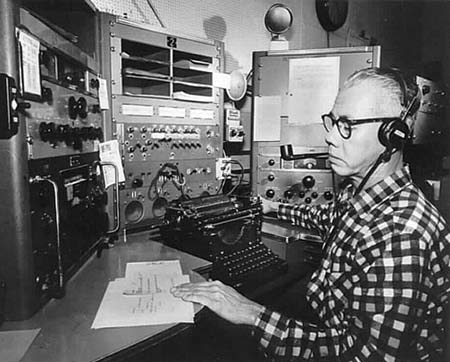 |
Although single receiver operation was common, RCA/RMCA also
utilized the AR-88 at installations in a triple diversity receiver
designated the DR-89. In late-1945, RCA replaced the AR-88 with the CR-88
which placed the Crystal Phasing control on the front panel and reduced
the size of the RF Gain and AF Gain control knobs so all three controls
would fit just below the tuning dial. The CR-88A replaced the AR-88F in
the diversity receivers.
photo left: Radiomarine Corp. Coastal Station KPH
operator, Fred Baxter, flanked by two RCA CR-88 receivers and a
Collins 51J-4 receiver. Photo
from KPH History website:
www.radiomarine.org |
|
Even the US Military used some of the later AR-88
variations in their installations that required a high performance,
highly reliable receiver. During the latter part of WWII the Navy had used a Triple diversity receiver
that was essentially the RCA DR-89 but was given the Navy designation of RDM. This diversity receiver was mainly used for data transmission in the form of CW, High-Speed CW and RTTY. Voice could be used but the RDM was
primarily
for reliable data reception. After WWII, the Navy continued to use the RDMs
up to the 1970s. By 1949, the U.S. Army Signal Corps wanted
their own version of the DR-89 for the same use as the Navy. RCA
supplied a slightly updated version of the DR-89 that was designated as OA-58A/FRC.
Not very many were produced with estimates being less than 100 OA-58s made. The
receiver used was the SC-88 of which about 300
were produced.
Some AR-88s found their way into monitoring
positions in several Shortwave BC stations around the world. By the
early 1950s, the RCA '88 receiver was still one of the best for stability,
sensitivity and high fidelity reproduction available.
|
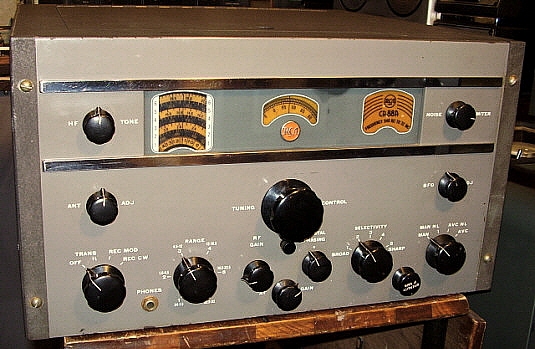
The CR-88A - post-WWII version of the
AR-88F from 1947 |
Even in the mid-1970s, these incredible diversity
receivers were still being used in RCA/RMCA
stations. Parts for maintaining the aging receivers were scrounged from
the WWII repair depots that had been set-up in Tangiers and San Juan,
Puerto Rico during WWII. Unfortunately, most (probably all) of these incredible
Triple Diversity Receivers were scrapped out with usually only the
receivers themselves surviving to be sold as surplus. |
With the modernized CR-88B, RCA began producing the last
AR-88 version in 1951. The CR-88B, is the only variant to actually
dramatically change the receiver, both in appearance and design. The
CR-88B increased the tube count to fifteen, adding Push-Pull audio
output. Also added was a
500kc Crystal Calibrator. Changes included a
two-position Tone control, a three-position Selectivity switch and a
different chassis layout that moved the power transformer forward behind
the front panel. The CR-88B was in limited production until 1953 and it
is the rarest of the entire series.
In the mid-1950s, the Chinese (PRC) built very close copies of
the CR-88 receiver, the WS-430. The front panel nomenclature is entirely in Chinese
as is the data plate attached to the receiver's chassis. Russian "octal"
tubes are used in the earlier versions but later receivers were equipped
with some miniature tubes. Photo in "Collector's Gallery of AR-88
Series Receivers" in Part 4 of the article.
|

The
SC-88 (aka R-320/FRC) - component
receiver of OA-58A/FRC from 1950 |
Production level of the AR-88 series was rather high
during WWII with approximately 25,000 total receivers built. After WWII,
the demand was greatly reduced since the only users were commercial
users and the military. The AR-88 series was never offered to the ham
market and was generally not available as a new product to the average
consumer. The serial numbers seem to indicate that post-WWII production
was less than 10,000 total receivers and probably closer to about 5,000.
This estimate brings the total AR-88 series production to around 30,000
receivers - far less than the normally quoted 100,000 (or more) receiver production.
So, what was the selling price of the AR-88? It seems to
be a mystery lost in the bureaucracy of the Lend-Lease Act and later RCA
commercial advertising. By comparing the AR-88 receiver to its
predecessor, the AR-60 that sold for $475 in the configuration used by
the USCG (the CGR-32-1,) one could estimate that the AR-88 cost at least
$475 but probably somewhat more since the cost-comparison CGR-32-1 was from
the late-thirties. Of
course, this is just a guess. If anyone does know a specific price
assigned to any of the AR-88 versions, please e-mail me and I will add
that information to this article. $495 is listed as the selling price
from other Internet sites but the caveat is that it's still just a guess.
|

The CR-88B version of the AR-88
from 1952 |
| photo above:
This is the last of the AR-88 series, the 1951-53 CR-88B. Note the
dial mask, the different placement of controls, different front panel
mounting and the shorter chrome strips. Note the three position
SELECTIVITY switch, 500kc CAL switch and the two position TONE switch.
Inside, the "B" has push-pull audio output. This excellent condition example of this
rare receiver is owned by N6YW who provided this photo (also see
Collector's Gallery.) |
Today, the AR-88 and its variants can be found in
vintage radio ham shacks and at dedicated SWL set-ups around the world. Its
global fame was
earned with hard work providing great performance, reliability and durability in service. This
"hard work" has resulted in many
AR-88 survivors being found in rough condition, missing parts and, many
times, non-functional. Fortunately, there are still plenty of enthusiasts that
scavenge parts in order to perform operational restorations of these
incredibly stout receivers. With fans around the world, the AR-88 and
its variants are assured of continuing survival.
|
